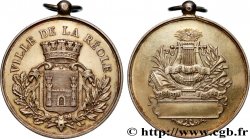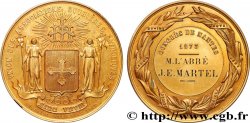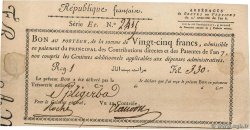fme_412194 - III REPUBLIC Médaille de la compagnie franco-roumaine de navigation aérienne
Not available.
Item sold on our e-shop (2017)
Price : 150.00 €
Item sold on our e-shop (2017)
Price : 150.00 €
Type : Médaille de la compagnie franco-roumaine de navigation aérienne
Date: 1920
Mint name / Town : 75 - Paris
Metal : copper
Diameter : 71,5 mm
Orientation dies : 12 h.
Engraver NOCQ Henry (1869-1942)
Weight : 156 g.
Edge : lisse + triangle CUIVRE
Coments on the condition:
Intéressante médaille, avec une patine sombre, dans sa boîte en carton vert
Obverse
Obverse legend : QAVA SINT QVAE FVERINT QVAE MOX VENTVRA TRAHANTVR.
Obverse description : Une diligence, un automobile, un train et un avion.
Reverse
Reverse legend : COMPAGNIE FRANCO-ROUMAINE DE NAVIGATION AÉRIENNE // FONDÉE EN AVRIL 1920 / PAR ARISTIDE BLANK.
Reverse description : Deux avions en vol au-dessus d’une carte d’Europe avec l’itinéraire Paris Constantinople avec escale à .
Commentary
Henry Nocq, né Marie Eugène Henri Auguste Nocq le 13 janvier 1868 et mort en 1944, est un sculpteur et graveur-médailleur français. Il a exécuté de nombreux bijoux remarquables.
Élève de Henri Chapu (1833- 1891), c'est un sculpteur, graveur, médailleur, mais aussi un peintre et un aquarelliste. Grand prix de Rome, sociétaire de la Société des artistes français. Dès 1887, Il participe régulièrement au Salon des artistes français et reçoit une mention honorable en 1889. Il est honoré d'une Médaille d'argent à l'Exposition universelle de 1900.
Ouvert à tous les arts et touche-à-tout de génie, il participe à une remise en cause de la hiérarchie entre arts majeurs et arts mineurs, en adhérant en 1896 à un un groupe d’artiste, dénommé « Les Cinq », avec Félix Anthyme Aubert, Alexandre Charpentier, Charles Plumet, et François-Rupert Carabin transformé en 1898 en un mouvement : L'Art dans Tout.
Il écrit plusieurs ouvrages consacrés à l'orfèvrerie, dont Le Poinçon de Paris publié en cinq volumes de 1926 à 1931, où il recense les orfèvres parisiens et leurs poinçons. Cet ouvrage continue à faire référence.
En 1920, la Compagnie franco-roumaine de navigation aérienne est créée. Elle devient en 1925, la Compagnie internationale de navigation aérienne formant l'acronyme Cidna, ex-franco-roumaine, qui dessert l'Europe centrale. C'est une des compagnie à l'origine d'Air France. Dans les années 1930, elle constitue une des quatre principales compagnies françaises pour le transport de passagers (la cinquième, l'Aéropostale dessert l'Amérique du Sud, essentiellement en transport de courrier) :
Air Union et les lignes Farman desservent l'Europe occidentale.
la Compagnie internationale de navigation aérienne (Cidna) dessert l'Europe centrale.
Air Orient étend son réseau vers la Méditerranée et l'Extrême-Orient.
Paul Morand raconte, au début des années 1930, dans Flèche d’Orient le vol à bord d'un avion de la Cidna de Paris à Bucarest, en vingt heures en faisant escale à Strasbourg, Nuremberg, Vienne et Budapest à la folle vitesse de 150 km/h.
La concrétisation et la mise en oeuvre réelle de la Compagnie Franco-Roumaine appartiennent au comte Claret de Fleurieu. Avant d’être nommé Directeur Général de la Compagnie Franco-Roumaine, il en conçut le projet de développement qu’il mena ensuite à bien, dans l’exercice de ses fonctions, grâce à l’appui moral et financier du banquier roumain Aristide Blank, Président de la grande banque d’affaires de Roumanie Marmorosch Blank & Cie et avec le concours irremplaçable des autres éminents pionniers de cette magnifique entreprise..
Henry Nocq, born Marie Eugène Henri Auguste Nocq on January 13, 1868 and died in 1944, was a French sculptor and engraver-medalist. He executed many remarkable jewels.
A student of Henri Chapu (1833-1891), he was a sculptor, engraver, medalist, but also a painter and a watercolorist.. Grand Prix de Rome, member of the Society of French Artists. From 1887, he regularly participated in the Salon des artistes français and received an honorable mention in 1889.. He was awarded a Silver Medal at the 1900 World's Fair..
Open to all arts and a genius jack-of-all-trades, he participated in a challenge to the hierarchy between major and minor arts, by joining in 1896 a group of artists, called \\\"The Five\\\", with Félix Anthyme Aubert, Alexandre Charpentier, Charles Plumet, and François-Rupert Carabin transformed in 1898 into a movement: Art in Everything.
He wrote several works devoted to goldsmithing, including Le Poinçon de Paris published in five volumes from 1926 to 1931, in which he lists Parisian goldsmiths and their hallmarks.. This work continues to be a reference.
In 1920, the Franco-Romanian Air Navigation Company was created. In 1925, it became the International Air Navigation Company, forming the acronym Cidna, formerly Franco-Romanian, which serves Central Europe.. It is one of the companies behind Air France.. In the 1930s, it was one of the four main French passenger transport companies (the fifth, Aéropostale, served South America, mainly for mail transport): Air Union and Farman lines served Western Europe.
The International Air Navigation Company (Cidna) serves Central Europe.
Air Orient expands its network to the Mediterranean and the Far East.
In Flèche d'Orient, Paul Morand recounts, in the early 1930s, the flight aboard a Cidna plane from Paris to Bucharest, in twenty hours, stopping in Strasbourg, Nuremberg, Vienna and Budapest at the crazy speed of 150 km/h..
The realization and actual implementation of the Franco-Romanian Company belongs to Count Claret de Fleurieu. Before being appointed Director General of the Franco-Romanian Company, he conceived the development project which he then carried out, in the exercise of his functions, thanks to the moral and financial support of the Romanian banker Aristide Blank, President of the large Romanian investment bank Marmorosch Blank & Cie and with the irreplaceable assistance of the other eminent pioneers of this magnificent enterprise..
Élève de Henri Chapu (1833- 1891), c'est un sculpteur, graveur, médailleur, mais aussi un peintre et un aquarelliste. Grand prix de Rome, sociétaire de la Société des artistes français. Dès 1887, Il participe régulièrement au Salon des artistes français et reçoit une mention honorable en 1889. Il est honoré d'une Médaille d'argent à l'Exposition universelle de 1900.
Ouvert à tous les arts et touche-à-tout de génie, il participe à une remise en cause de la hiérarchie entre arts majeurs et arts mineurs, en adhérant en 1896 à un un groupe d’artiste, dénommé « Les Cinq », avec Félix Anthyme Aubert, Alexandre Charpentier, Charles Plumet, et François-Rupert Carabin transformé en 1898 en un mouvement : L'Art dans Tout.
Il écrit plusieurs ouvrages consacrés à l'orfèvrerie, dont Le Poinçon de Paris publié en cinq volumes de 1926 à 1931, où il recense les orfèvres parisiens et leurs poinçons. Cet ouvrage continue à faire référence.
En 1920, la Compagnie franco-roumaine de navigation aérienne est créée. Elle devient en 1925, la Compagnie internationale de navigation aérienne formant l'acronyme Cidna, ex-franco-roumaine, qui dessert l'Europe centrale. C'est une des compagnie à l'origine d'Air France. Dans les années 1930, elle constitue une des quatre principales compagnies françaises pour le transport de passagers (la cinquième, l'Aéropostale dessert l'Amérique du Sud, essentiellement en transport de courrier) :
Air Union et les lignes Farman desservent l'Europe occidentale.
la Compagnie internationale de navigation aérienne (Cidna) dessert l'Europe centrale.
Air Orient étend son réseau vers la Méditerranée et l'Extrême-Orient.
Paul Morand raconte, au début des années 1930, dans Flèche d’Orient le vol à bord d'un avion de la Cidna de Paris à Bucarest, en vingt heures en faisant escale à Strasbourg, Nuremberg, Vienne et Budapest à la folle vitesse de 150 km/h.
La concrétisation et la mise en oeuvre réelle de la Compagnie Franco-Roumaine appartiennent au comte Claret de Fleurieu. Avant d’être nommé Directeur Général de la Compagnie Franco-Roumaine, il en conçut le projet de développement qu’il mena ensuite à bien, dans l’exercice de ses fonctions, grâce à l’appui moral et financier du banquier roumain Aristide Blank, Président de la grande banque d’affaires de Roumanie Marmorosch Blank & Cie et avec le concours irremplaçable des autres éminents pionniers de cette magnifique entreprise..
Henry Nocq, born Marie Eugène Henri Auguste Nocq on January 13, 1868 and died in 1944, was a French sculptor and engraver-medalist. He executed many remarkable jewels.
A student of Henri Chapu (1833-1891), he was a sculptor, engraver, medalist, but also a painter and a watercolorist.. Grand Prix de Rome, member of the Society of French Artists. From 1887, he regularly participated in the Salon des artistes français and received an honorable mention in 1889.. He was awarded a Silver Medal at the 1900 World's Fair..
Open to all arts and a genius jack-of-all-trades, he participated in a challenge to the hierarchy between major and minor arts, by joining in 1896 a group of artists, called \\\"The Five\\\", with Félix Anthyme Aubert, Alexandre Charpentier, Charles Plumet, and François-Rupert Carabin transformed in 1898 into a movement: Art in Everything.
He wrote several works devoted to goldsmithing, including Le Poinçon de Paris published in five volumes from 1926 to 1931, in which he lists Parisian goldsmiths and their hallmarks.. This work continues to be a reference.
In 1920, the Franco-Romanian Air Navigation Company was created. In 1925, it became the International Air Navigation Company, forming the acronym Cidna, formerly Franco-Romanian, which serves Central Europe.. It is one of the companies behind Air France.. In the 1930s, it was one of the four main French passenger transport companies (the fifth, Aéropostale, served South America, mainly for mail transport): Air Union and Farman lines served Western Europe.
The International Air Navigation Company (Cidna) serves Central Europe.
Air Orient expands its network to the Mediterranean and the Far East.
In Flèche d'Orient, Paul Morand recounts, in the early 1930s, the flight aboard a Cidna plane from Paris to Bucharest, in twenty hours, stopping in Strasbourg, Nuremberg, Vienna and Budapest at the crazy speed of 150 km/h..
The realization and actual implementation of the Franco-Romanian Company belongs to Count Claret de Fleurieu. Before being appointed Director General of the Franco-Romanian Company, he conceived the development project which he then carried out, in the exercise of his functions, thanks to the moral and financial support of the Romanian banker Aristide Blank, President of the large Romanian investment bank Marmorosch Blank & Cie and with the irreplaceable assistance of the other eminent pioneers of this magnificent enterprise..







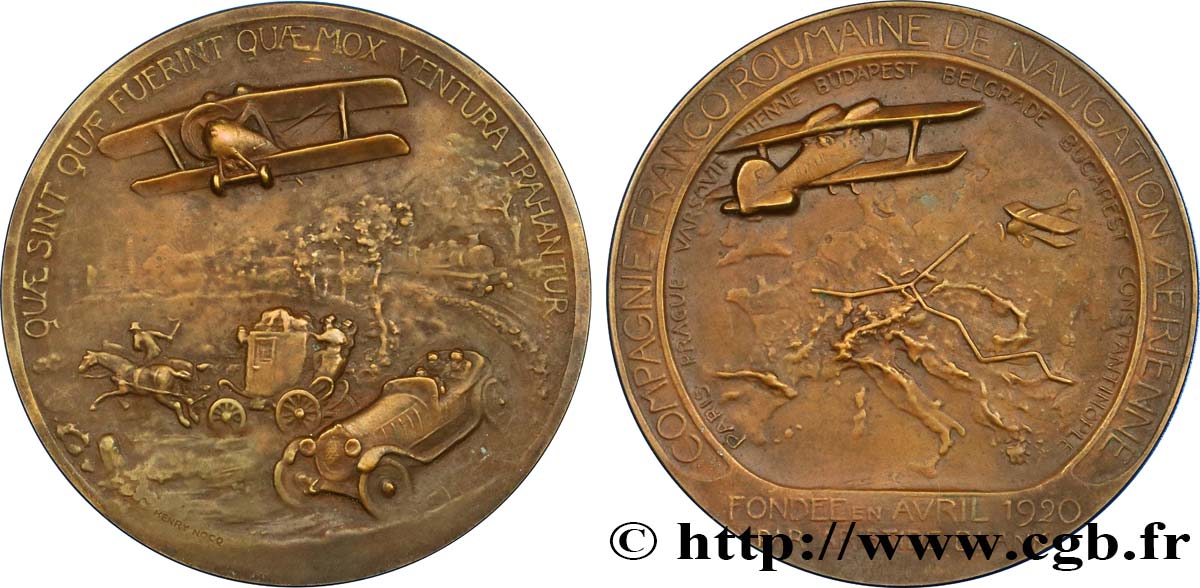
 Report a mistake
Report a mistake Print the page
Print the page Share my selection
Share my selection Ask a question
Ask a question Consign / sell
Consign / sell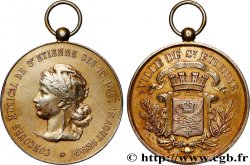
 Full data
Full data